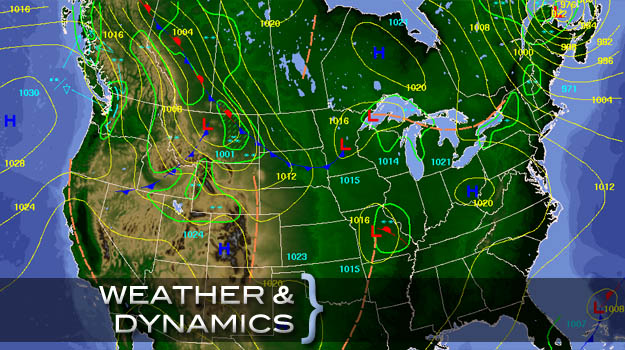Description
Atmospheric models are based on the physical/dynamical equations that govern the atmospheric flow, written as a computer code. These codes are initialized with data created by combining short model forecasts with new observations (a process called data assimilation). When a model is integrated in time (i.e., the model codes are run) starting from the initial conditions, the output is a numerical weather prediction. These numerical forecasts provide guidance to human forecasters and are the basis of all the National Weather Service and media weather forecasts.
The increase in our prediction capabilities over the past twenty years is mostly attributable to the improvements that have taken place in these computerized weather forecasts, through the better use of the observations, and the use of more advanced models and of more powerful computers.
Our department is involved in many of current developments in Numerical Weather Prediction and Data Assimilation: very high resolution, non-hydrostatic models (mesoscale meteorology) as for example the mesoscale model runs for regional air pollution studies, new numerical methods for the dynamical equations, advanced physical processes, advanced methods for data assimilation, coupled ocean-atmosphere-land forecasts of El Nino, data assimilation for the Atlantic.
See also the UMDWeather-Chaos Project website.
Faculty and Appointments
Research Areas
Prof. Hugo Berbery is a Research Professor at ESSIC and Director for CICS-MD, the UMD component of the Cooperative Institute for Climate and Satellites. Dr. Berbery, a Fellow of the American Meteorological Society, has research interests in regional hydroclimate variability, monsoon systems and land surface-atmosphere interactions. He is currently serving as Co-chair of the International CLIVAR’s Variability of the American Monsoon Systems (VAMOS) Panel and as a member in other international panels.
Prof. Tony Busalacchi, Former Director of ESSIC, now on leave as President of UCAR, is interested in data assimilation as it pertains to state estimation and initialization of ocean circulation models, coupled ocean-atmosphere models, and coupled physical-biological ocean models.
Prof. Jim Carton: Atmospheric and Oceanic Science Department Chair. His group collaborates with UMD, NASA, and NOAA scientists with the goal of providing consistent analysis of climate variables across air/sea/sea ice boundaries.
Prof. Kayo Ide is interested in the dynamics of atmosphere and oceans. Her research in data assimilation focuses on the development of methodology, including Lagrangian data assimilation, observing system design, non-Gaussian filtering, nonlinear filtering. She is the leader of the UMD Weather and Chaos group, which meets monthly and has more than 30 members.
Prof. Eugenia Kalnay is interested in atmospheric predictability problems, from mesoscale to the coupled ocean-atmosphere system. Her book, Atmospheric Modeling, Data Assimilation and Predictability (Cambridge University Press, 2003) is on its third printing. At the University of Maryland, she and Prof. Jim Yorke started an interdisciplinary group (Weather and Chaos) on data assimilation that developed the advanced Local Ensemble Kalman Filter (see Data Assimilation, below). She has directed the first Multidecadal Reanalysis and her paper (Kalnay et al., 1997) is the most cited in all geophysics.
Prof. Daryl Kleist research interests include data assimilation, numerical weather prediction, atmospheric predictability, targeted observing, data thinning and forecast sensitivity. His data assimilation research has primarily focused on improving initial conditions through algorithm development for operational numerical weather prediction for short- and medium-range time scales. Most recently, he has worked on developing and testing a hybrid ensemble-variational (EnVar) algorithm with an extension to four dimensions that does not require the use of an adjoint model, which was implemented operationally at NCEP in 2016.
Prof. Xin-Zhong Liang, is the main developer of several regional and global climate models, including the widely used regional climate model CWRF, with many new physical parameterizations. His models have been applied to study seasonal-interannual-decadal climate variability and predictability, including Monsoons, ENSO, climate feedbacks, and impact of anthropogenic emissions.
Prof. Takemasa Miyoshi, now Team Leader of Data Assimilation at RIKEN, Japan, where the K supercomputer is located, was the youngest receiver of the is interested in data assimilation with chaotic dynamical systems, particularly the weather systems and other components of the climate systems, and even the Martian atmosphere. He was the youngest recipient of the Meteorological Society of Japan top Award (2016).
Prof. Steve Penny, is working on Ocean and Coupled-Model Data Assimilation from research level to full operational implementations) and fundamental methods in data assimilation. He has designed novel methods for data assimilation under non-optimal conditions, such as sparse observational data sets, short spin-up times, including the Gain Hybrid method tested with success at ECMWF.
Prof. Da-Lin Zhang works on the modeling and understanding of fundamental processes taking place in squall lines, mesoscale convective complexes, hurricanes and heavy rain- (or snow-) storms, tropical and extratropical cyclones, gravity waves, frontal circulations and topographically generated weather phenomena. His research interests also include the development and improvement of the planetary boundary layer and cumulus parameterization techniques, cloud representations in mesoscale numerical models, and the improvement of warm-season quantitative precipitation forecasts and severe weather warnings.
